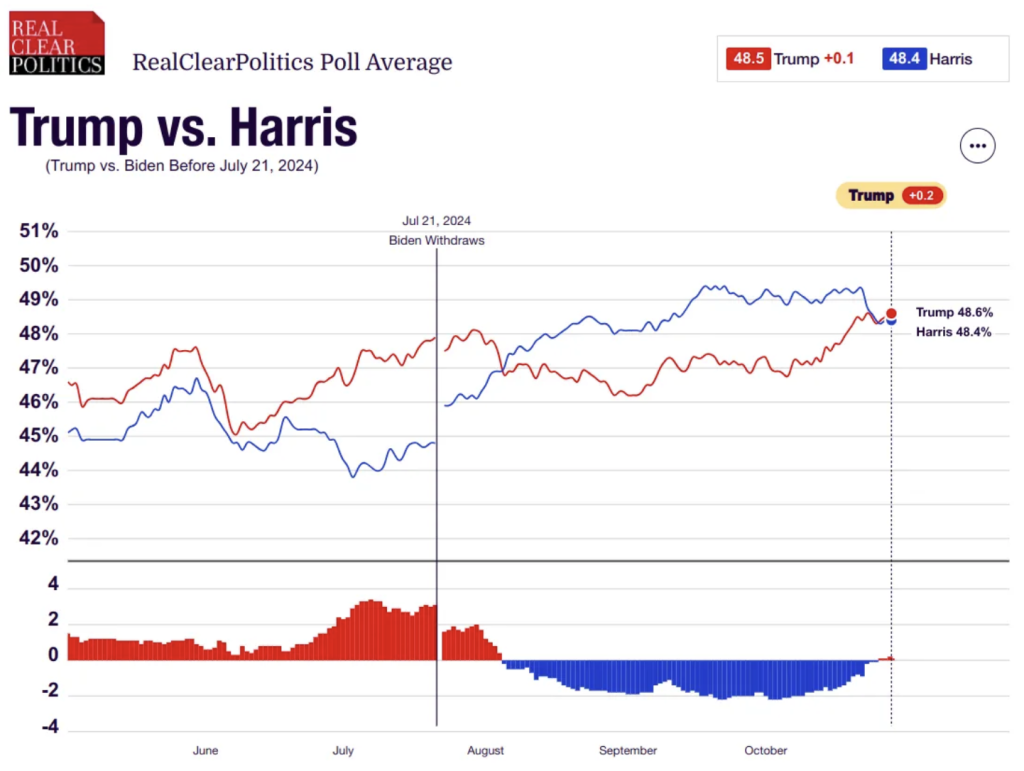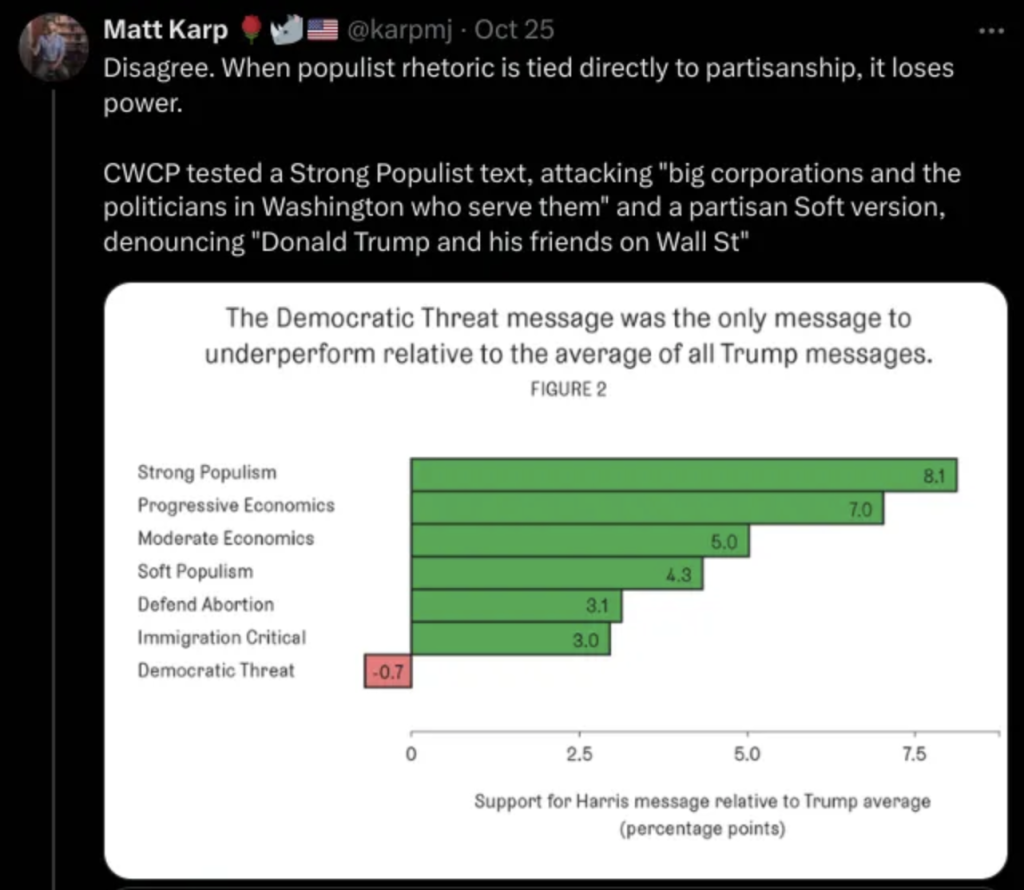Conor here: A quote comes to mind.
“How many more of these stinking, double-downer sideshows will we have to go through before we can get ourselves straight enough to put together some kind of national election that will give me and the at least 20 million people I tend to agree with a chance to vote FOR something, instead of always being faced with that old familiar choice between the lesser of two evils?”
-Hunter S. Thompson, Fear and Loathing on the Campaign Trail ’72
And the lesser of two evils—including whoever it is this go-round—often seem to get more evil.
By Thomas Neuburger. Originally published at God’s Spies

I’m trying not to comment much on the election, but I will say this: It’s Harris’s race to lose, and she might lose it.
Why?
A Change Election?
Some analysts think this is still a change election — I’m among them — and many voters are still sick of billionaires running their lives. So what can those who want change do in this election? Democrats are still the party of “keep things the same, only better.” Not much change in that; or at least, not enough.
So what’s left to do? Voters who want change can support an agent of chaos (that’s definitely Trump) and upset the cart entirely, or they can stay home. Trump already has all his voters (see below), so the choices become either Harris or stay at home.
Unstrategic? You could say that. But angry people, in the main, aren’t perfect strategists, and the very very angry aren’t strategic at all.
The stay-at-home strategy hurts Harris the most, since Trump, as I see it, maxed out his voting ranks a long time ago — his peak is always near 48% — while Harris could still grow hers among undecideds. Yet instead of gaining new votes, her growth has stopped or receded. (See chart above.) Undecideds aren’t breaking in her direction, at least not in good enough numbers. Her campaign has stalled.
Working Class Voters
To try to determine why Harris has stalled, a survey by the Center for Working-Class Politics, YouGov and Jacobin magazine, tested various messages with workers in Pennsylvania, a key swing state. They chose five gleaned from her actual campaign and two alternatives, trying to see what worked best.
The real messages tested (those based on her campaign) were these:
- The Soft Populist message acknowledges that most businesses are job creators and play by the rules but calls out big corporations and Wall Street for price gouging and not paying their fair share of taxes.
- The Moderate Economic message focuses on Harris’s economic vision of an “opportunity economy” that achieves broad-based growth and emphasizes tax cuts for middle-class Americans.
- The Democratic Threat message calls on voters to defend democracy and liberal norms against the threat posed by Trump, highlighting his felony criminal convictions.
- The Defend Abortion message emphasizes Harris’s support of abortion rights against Republican proposals to enact a nationwide abortion ban, a position she attributes to Trump.
- The Immigration Critical message underscores Harris’s support for increased border security while facilitating a path to citizenship for immigrants who play by the rules.
The messages that weren’t from her campaign were these:
- The Strong Populist message more aggressively targets economic elites for getting richer while working Americans suffer, sets up a strong contrast between the working class and the billionaire class, and blames not only economic elites and Trump (as in the Soft Populist message) but a wider cast of Washington politicians for leaving workers behind.
- The Progressive Economic message foregrounds progressive economic positions, some of which Harris has already endorsed but often fails to emphasize, along with some policies that fall outside the campaign’s current policy proposals. These policies include reshoring American jobs, guaranteeing jobs for all those looking for work, and expanding Medicare access to include younger Americans who lack adequate health insurance.
Matt Karp summarized the results. The solution is clear. Nonpartisan populism beats all other messages, including partisan, anti-Trump populism; and the “threat to democracy” message actually loses some voters.

Apparently people still hate the billionaires. Yet Harris and her strategists persist in the partisan populist message and “threat to democracy.” To working class voters convinced the system is (still) rigged, she doesn’t look like the answer.
Democracy Under Threat
The failure of the threat-to-democracy message deserves comment. Trump has indeed let his strongman flag fly, proving to liberals that this threat is real. So why doesn’t this message work with the working class?
The answer is implied by the discussion above, but some writers make it explicit. Working class people are the primary national victims of billionaire greed. So what do they see as the threat, Republicans or billionaires?
Here’s Carl Beijer’s take: “‘Democracy is at stake’ messaging only works in a democracy”. From the paywalled part of his piece:
I would argue … that “democracy is at stake” messaging only works in a functional democracy. And since most people don’t think of the US as a functional democracy, most people don’t think that it’s actually “at stake” in any meaningful sense.
He explains, referencing the survey discussed above:
[W]hen Democrats start going on about how Trump could suspend elections or crack down on free speech or launch all kinds of other attacks on liberal democracy, a lot of people just shrug because they already think they have nothing left to lose.
The advantage of this explanation is that it also explain[s] the popularity of the Strong Populist message — which, again, emphasizes that DC actually answers to the powerful rather than the people. [emphasis mine]
So yes, people might believe democracy is at stake. But maybe, just maybe, they define the problem as bipartisan, and Harris, in doing not much to “take on the billionaires” (to quote a once popular populist), fails to look like the answer.
Of course, we’ll find out soon what worked and what didn’t. But the “embrace Dick Cheney and comfort the rich” approach could cost her a lot.


